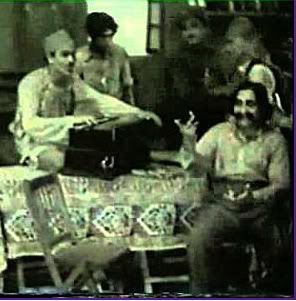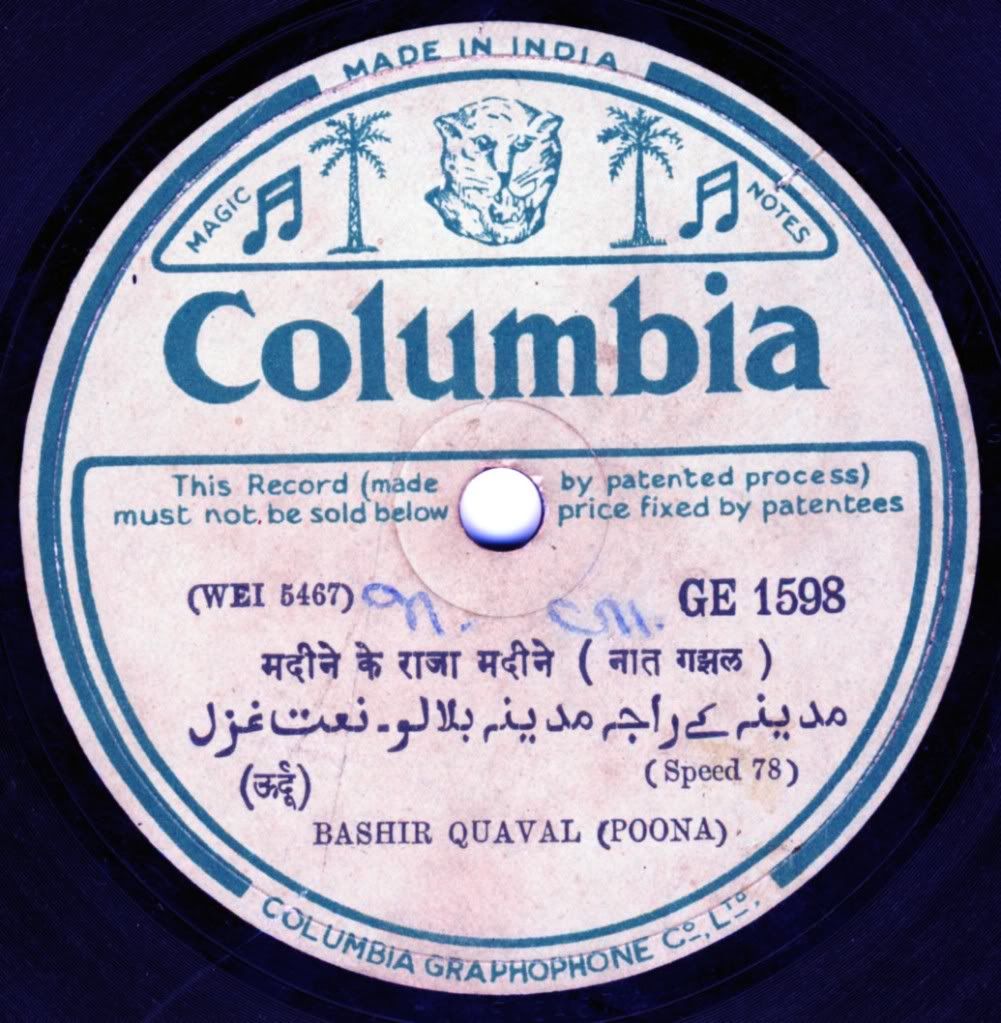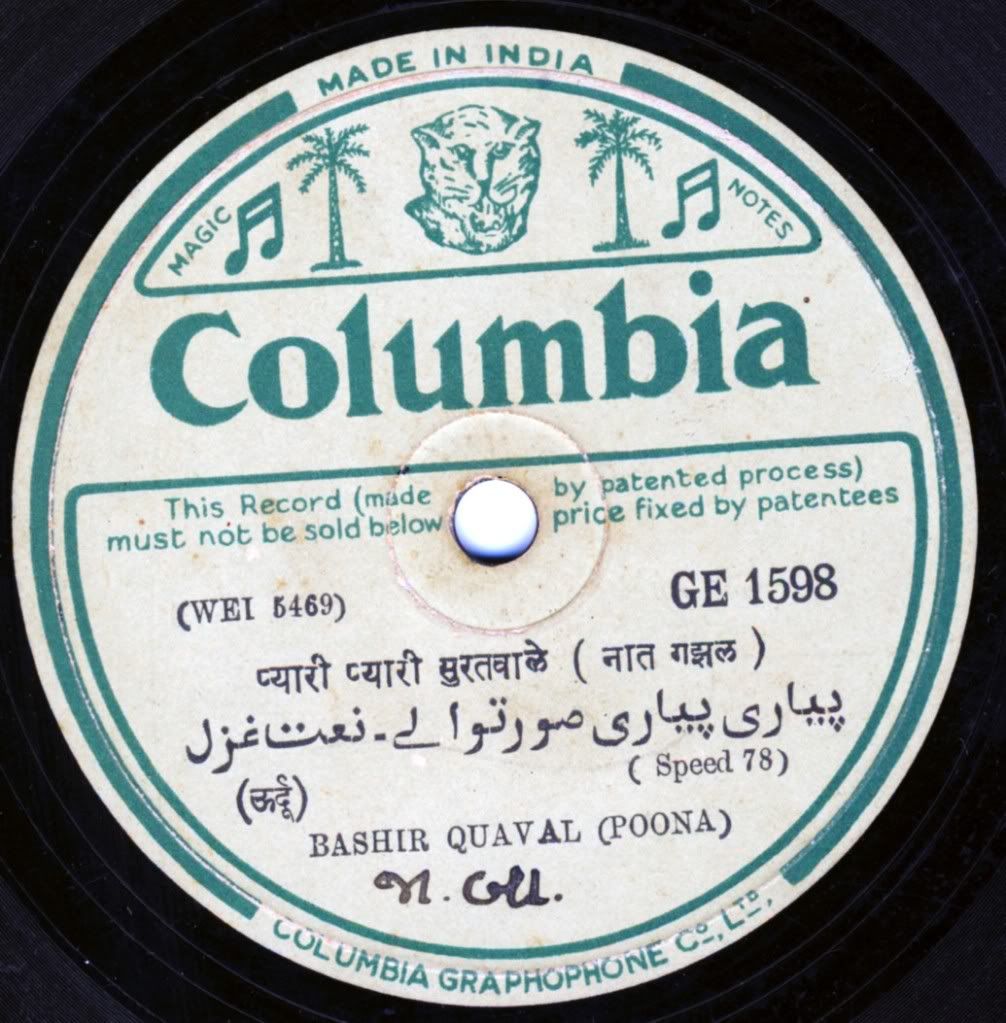India Indian music music: 78 rpm discs Dance genius
by Warren
1 comment
Meta
SiteMeter
Brighter Planet
78 rpm Records of Indian Music: Kathak Dance by Sitara Devi
Here is a very unusual item: four 3-minute performances of Kathak dance by the great Sitara Devi:
Sitara Devi (born early 1920s on a Diwali day) is an eminent Indian dancer of the classical Kathak style of dancing. When she was in her teens, Rabindranath Tagore, after watching a performance by her described her as Nritya Samragini, meaning, the empress of dance. The epithet continues, and she is still described as the Kathak queen.
Wiki

This rare boxed set was part of a group of 78s that were sent to me by a fellow collector.
Sitara Devi is among the great dancers of modern India. Born in Calcutta, she was trained in Kathak by her father Shri Sukhdev Maharaj Misra and by masters of Lucknow gharana including Achhan Maharaj, Lachhu Maharaj and Shambu Maharaj. She has combined the traditions of Banaras and Lucknow in her performance of Kathak.
An exhaustive treatment of the entire gamut of nritta, sometimes in different talas, interspersed with gats of lyrical beauty and compositions of dramatic intensity followed by moving renditions of thumris and Bhajans constitute the format of her hours long performances, characterized by an electrifying energy. In many ways she represents a lost era of complete Kathak performed all night with the accompaniment of masters of Tabla like Kanthe Maharaj, Samta Prasad and Kishan Maharaj.
Sitara Devi has danced extensively in India and abroad contributing to the popularization of the art. She has also been an actess and dancer in films since the silent era. In a class of her own, she continues to inspire her audience and fellow artists.
She has been honoured with the Sangeet Natak Akademi Award (1969) and the Padma Shri.
Moordhan Poornam & Trotakam
Parahang
Padakriya (Tatkar)
Tarana
India Indian music music: 78 rpm discs genius
by Warren
2 comments
Meta
SiteMeter
Brighter Planet
78 rpm Records of Indian Music: Ustad Abdul Aziz Khan
Four performances by the great vichitra veena artist Ustad Abdul Aziz Khan.
Ustad Abdul Aziz Khan.
Originally a Sarangi player in Mumbai, he was the first person to play Khayals and Thumris in Vichitra Veena. After his maiden performance, at the annual music conference of the Gandharva Mahavidyalaya, Lahore, he never had to look back. He preferred Tabla accompaniment to Pakhawaj. He had been the court musician to the Maharaja of Patiala.
The Vichitra Veena emerged towards the beginning of the twentieth century and is descended from the ektantri veena or the ghoshvati veena as it was known, prior to the 6th century. It shared the same sound production techniques as the ektantri. The credit of giving the vichitra veena its present shape and developing its modern style of playing goes to Abdul Aziz Khan, a former sarangi player of Patiala. Today, the vichitra veena remains a rare instrument, with not many artists who play this instrument.
Raga Darbari Kanada — a different performance of this raag from the one posted earlier (he doesn’t give himself any daad, for one thing):
The beautiful compound morning raga Jogiya Asavari:
Raga Misra Pilu:
Raga Bhairavi:
India Indian music music: 78 rpm discs genius sitar
by Warren
1 comment
Meta
SiteMeter
Brighter Planet
78 rpm Records of Indian Music: Ustad Vilayat Khan
These sides feature Vilayat Khan at the early height of his powers. Listening through the surface noise and distortion is worth it; he plays with intensity, concentration and emotional clarity in a way that has never been duplicated.

This is not the cover of the record you are listening to.
Wiki:
Vilayat Khan was born in Gauripur, British India to Enayat Khan, a sitar maestro. His family of musicians trace their pedigree back to the court musicians of the Mughals. His father, recognised as a leading sitar and surbahar (bass sitar) player of his time, as had been the grandfather, Imdad Khan, before him. He was taught in the family style, known as the Imdadkhani Gharana or Etawah Gharana, after a village outside Agra where Imdad Khan lived.
However, Enayat Khan died when Vilayat was only nine, so much of his education came from the rest of his family: his uncle, sitar and surbahar maestro Wahid Khan, his maternal grandfather, singer Bande Hassan Khan, and his mother, Bashiran Begum, who had studied the practice procedure of his forefathers. Vilayat’s uncle Zinde Hassan looked after his riyaz (practice). As a boy, Vilayat wanted to be a singer; but his mother, herself from a family of vocalists, felt he had a strong responsibility to bear the family torch as a sitar maestro.
Raga Shyam Kalyan
Raga Bhairavi:
Vilayat Khan taught or otherwise influenced many of of today’s prominent musicians. These include Vilayat Khan’s two sons Ustad Shujaat Khan, and Hidyat Khan, as well as Pdt. Arvind Parikh. Even Vilayat Khan’s younger brother, Ustad Imrat Khan (sitar and surbahar) was taught by him in his younger days. It should also be noted that Vilayat Khan’s nephew Rais Khan is also a famous sitarist.
Vilayat Khan died of lung cancer at the Jaslok Hospital in Mumbai on March 13th, 2004. He was 75 years of age.
India Indian music music: 78 rpm discs vichitra veena
by Warren
1 comment
Meta
SiteMeter
Brighter Planet
78 rpm Records of Indian Music: Ahmed Raza – Vichitra Veena
More virtuoso performances on the Hindustani equivalent of the lap slide guitar, this time from Ahmed Raza Beenkar, with Ghulam Ahmed accompanying on tabla.
Any information about Ahmed Raza will be heartily welcomed.
Raga Maru Bihag:
Thumri:
India Indian music music: genius sitar surbahar
by Warren
3 comments
Meta
SiteMeter
Brighter Planet
78 rpm Records of Indian Music: Ustad Enayet Khan
Ustad Enayet Khan is one of the most important names in Hindustani instrumental tradition, both for his own genius and for his illustrious ancestry and descendants.
Wiki:
Enayat Khan (Urdu: عنایت خان ) was one of India’s most influential sitar and surbahar players in the first decades of the 20th Century. He was the father of Vilayat Khan, one of the topmost sitariyas of the postwar period.Enayat Khan was born in Uttar Pradesh into a family of musicians.[1] His father was sitar great Imdad Khan, who taught him the sitar and surbahar (bass sitar) in the family style, known as the Imdadkhani Gharana or Etawah Gharana (school), after a village outside Agra where Imdad once lived. He married Basiran Bibi, daughter of khyal singer Bande Hussain, and settled with his family in Calcutta, where, though he only lived to 43, he did much pioneering work on the sitar. For example, he standardised its physical dimensions and added the upper resonator gourd, which is very popular with today’s players (though his own descendants have not kept using it). In a place rapidly developing into an important North Indian centre of the arts, at a time where interest in national culture was strong fuelled by the struggle for independence, he brought sitar music out from its narrow connoisseur circles to new mass audiences. Nobel laureate Rabindranath Tagore was a musical collaborator and personal friend. Some of Enayat Khan’s recordings have been released on CD, on the Great Gharanas: Imdadkhani compilation in RPG/EMI’s Chairman’s Choice series.
Enayat died young, with four children. His two sons, Vilayat and Imrat, were trained in the Imdadkhani style by other members of his extended family. Vilayat learned the sitar and Imrat the surbahar; both were to become very famous classical musicians.
Surbahar alap: Raga Purbi
Sitar Gat in Raga Bihari
India Indian music music vocalists: 78 rpm discs genius violin
by Warren
leave a comment
Meta
SiteMeter
Brighter Planet
78 rpm Records of Indian Music: Gajananrao Joshi’s Violin Virtuosity
The great Gajananrao Joshi. Both a violinist and a vocalist, he was one of the most competent and intelligent musicians of the century:
Wiki:
Joshi was a highly skilled violin player by the age of 20. His students include vocalist and violinist Madhukar Joshi, Vikas Kashalkar, Ulhas Kashalkar, Padma Talwalkar, and violinist Shridhar Parsekar. He also taught vocalists Kaushalya Manjeshwar, Shubhada Paradkar, Veena Sahasrabuddhe and Jayashree Patnekar. His daughter Malini, sons Manohar, Madhukar and Narayan are also trained musicians. His sons variously took to singing, violin, and tabla.
His grasp was so quick that it is said that Kesarbai Kerkar did not like to have him attend her concerts because he could quickly incorporate her strengths in his own singing. His gurus—father Anant Manohar Joshi of Gwalior, He was also a disciple of the late Pandit Balkrishnabau Vaze of the Gwalior Gharana Vilayat Hussein Khan of Agra and Bhurji Khan of Jaipur—spanned the three gharanas whose blend is exhibited in his art.
As the guru of my own guru, Pt. Devasthali, Gajananrao Joshi has a special place in my personal musical pantheon. Mohan Nadkarni’s biographical article on Gajananbua is well worth a read.
These two sides showcase his violin artistry, which was of a piece with his singing: intelligent, uncompromising, beautiful.
Listen and enjoy!
Raga Todi
Raga Kafi
India Indian music music: 78 rpm discs Indian folk music snake-charmers
by Warren
1 comment
Meta
SiteMeter
Brighter Planet
78 rpm Records of Indian Music: Adu Nath – Been Lahara
This disc contains two short performances by Adu Nath on the been. This “been” is not the rudra vina, but the gourd-mounted double-reed instrument commonly heard in the hands of “snake charmers” all over North India.
The two performances are simply labeled “Been Lahara.” It was obviously a tough instrument to record, as witness the distorted sound. I’m hard-pressed to imagine just who HMV’s marketing division thought was going to buy this disc. Perhaps they were going to try and market it to the tourist trade?
This disc was part of a collection of 78s I acquired serendipitously in the United States.
Anyway, enjoy. I do.
India Indian music music vocalists: 78 rpm discs naat Quawwali Urdu
by Warren
3 comments
Meta
SiteMeter
Brighter Planet
78 rpm Records of Indian Music: Bashir Quaval of Poona
Unless I miss my guess, this still from the 1936 Hindi film Miss Frontier Mail (featuring Fearless Nadia!) is of Bashir Quaval playing harmonium and singing. He is featured on some songs in the movie, and the voice certainly sounds similar to these two naat-s. See the clip here.
Since much of India’s early film industry was based in Pune, the geographical suffix makes sense.


Madine ke raajaa madine

Pyaari pyaari suratwale
humor India Indian music music: 78 rpm discs novelty music
by Warren
2 comments
Meta
SiteMeter
Brighter Planet
78 rpm Records of Indian Music: V. Balsara
The keyboardist and composer V. Balsara was responsible for a great many releases of light music, including some film scores, orchestral projects and novelty recordings. These two sides present his harmonium virtuosity with ensemble accompaniment.
“Dance Tune 1”
“Dance Tune 2”
Born in June 1922, Balsara learnt music from his mother Nazamaye, and gave his first solo performance at the age of six with the pedal harmonium, in use in those times, at a packed C. J. Hall in Mumbai.
Barely ten years later, the young lad was assisting famous Music Director Ustad Mustaque Hussain, in a Bombay film production ‘Baadal’.Link
He died in 2005:
V. Balsara, synonymous with the sound of music in the city, died on Thursday afternoon. The legendary pianist and composer was 83.
Balsara, known for his versatility with an array of musical instruments, had been suffering from geriatric problems for the past few months and was undergoing treatment at his nephew’s residence in Ballygunge Park.
Chief minister Buddhadeb Bhattacharjee on Thursday expressed grief over the death of the virtuoso, who had been honoured with a D.Lit by Visva-Bharati, among a number of other awards.
{snip}
A thin, frail man, Balsara always amazed with his verve and energy and went on composing music for Bengali as well as Hindi films till the end.
Though essentially a western composer, Balsara traversed the Indian classical terrain with consummate ease.
{snip}
Balsara would often fuse eastern and western elements of music but was loath to call it fusion. “I merge pure Indian classical music with the most modern rhythms,” Balsara had told Metro during an interview at his Bowbazar house late last year. “In fact, I am allergic to the word fusion,” he had insisted.
Link
He was from all accounts a genuinely nice person and a fine musician. That said, to my compositional ears, Balsara’s work tended to the insipid:
He was not afraid to be simply silly:
Or even sillier:
India Indian music music: 78 rpm discs Hindi films
by Warren
3 comments
Meta
SiteMeter
Brighter Planet
78 rpm Records of Indian Music: Master Ibrahim (clarinet)
Once a good song came out in a popular movie, instrumental versions soon followed, often featuring the same orchestration that had been used in the original, with a clarinet, violin, harmonica, or piano substituted for the voice. One highly regarded “version tune” player was the clarinetist Master Ibrahim. Here he renders two songs from the 1943 film Poonji, both originally featuring the vocalist Shamshad Begum.
Ab koi tute hue dil ka sahara:
Gadiwale dupatta udaa jayaare:
Ruskin Bond was a fan of Master Ibrahim’s playing:
I was also fond of the clarinet (turj) playing of an Indian musician, Master Ibrahim, and I had some of his recordings which transported me back to the streets and bazaars of small-town India. Light, lilting and tuneful, I preferred this sort of flute music to the warblings of the more popular songsters.
